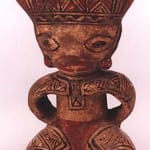Polychrome Female Figurine, 800 CE - 1100 CE
Terracotta
8.75
PF.3346
As the Guanacaste - Nicoya polychrome tradition came into full flower during Period V, the long tradition of seated female figurines continued. Archaeologists have classified this colorful sculpture and others...
As the Guanacaste - Nicoya polychrome tradition came into full flower during Period V, the long tradition of seated female figurines continued. Archaeologists have classified this colorful sculpture and others similar to it as Guabal Polychrome. They are dated two to four centuries after Galo Polychrome figurines. Apparently, the custom of all over body painting continued, but the striking realism that was the hallmark of certain Galo Polychrome pieces, however, did not carry over into this later type. This figurine is stylized, her features are not realistic. Her charm, though, still prevails. She has a tall, flattened headdress and small ear spools. The lower rim of her headdress has a continuous wavy line encircling the entire headdress. This symbol most probably represents water, so we may assume that she is a fertility goddess. There are three "crosses" on the front of the upper rim of her headdress and one large "cross" or "x" on the back. This symbol has yet to be interpreted by specialists in the field of Costa Rican archaeology. The various designs and crosshatched patterns on her arms, breasts and legs may have other connotations to fertility, which are not fully understood. Her physical features are stylized. The composition tends to be a rhythmic balance of geometric spheres and cones, which create her legs, arms and torso. Her earspools reveal to us that she is an important person or deity. Another piece of jewelry, a rectangular pendant, appears to be attached to her necklace. Her aura is bright and cheerful and we can imagine her being revered and held during rituals.



